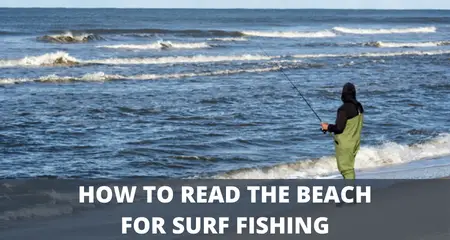How To Read The Beach For Surf Fishing
UPDATED 17 MAY 2023
by Robert Ceran
How do you read the beach in order to catch more fish? This is the subject of the vast majority of questions that I am asked by surf anglers everywhere.
Reading the beach translates to being able to spot sloughs, sandbars, shoals, and deep-water cuts in the bars that are likely to retain fish.
In this article I’ll give you my best advice on how to do this effectively.

What is a slough at a beach?
A slough (also called a gut) is a deep depression that often runs in the same direction as the beach and is bounded on one side by a sandbar and on the other by the beach.
The breadth of the slough is proportional to the distance that separates the bar and the shore.
Fish swim in both directions along this slough as they search for food in the dynamic surf zone, which is characterized by crashing waves and powerful currents.
Where to find a slough
At times of low tide, when the sand bars are exposed, it is not difficult to pinpoint the location of a slough.
Incoming waves will cause a sandbar to break on its surface if the water depth on the sandbar drops.
On a beach that has a gentle slope and no outer bar, the waves will gradually spill over and continue to do so until they ultimately crash on the beach.
This process will continue until the beach is completely covered. This type of beach is known as a flat beach.
How to find fish in a slough
The length of a slough’s breadth is another factor that can influence the kind of fish that live there.
Big species like red drum, striped bass, and bluefish have a tendency to choose the broader and deeper sloughs on the Outer Banks, particularly those that have some shallower water and shoal areas at each end.
The difference in water depth between low tide and high tide on the beaches of the Outer Banks is typically between two and three feet. This is the case under normal conditions.
When you have found a slough that appears to be fruitful, it is time to proceed with the examination.
A slough is like a highway that may be traveled by fish, but first they have to find a way to get on it. They are able to accomplish this by using a gap in the outer bar.
A wave will go over a bar that has a break in it, but it will not crest at the break because the water there is too deep for it to do so.
That qualifies as a cut in the bar if the incident keeps happening even when there are many sets of waves coming to the beach.
When the tide is going out, you may notice that the water at these gaps is rippling, flowing quickly, or has a discolored appearance.
Fish close to the gaps
The fast-moving water surrounding these breaks frequently forms rip currents, which send food spinning past the predator fish, such as striped bass, as they line up in front of the baitfish smorgasbord.
Fish enter the sloughs through these cracks, and the fast-moving water around these breaks often forms rip currents.
Reading the sand
Sand on the beach can also provide some insight about the topography of the ocean floor.
On beaches that slope gently from high to low, the sand tends to be very fine and packed firmly together.
A beach that slopes steeply would often include both coarse sand and smaller pebbles in its composition.
This coarse, huge grain sand can occasionally have a darker appearance than the tiny grain sand.
Along a beach that extends for a number of kilometers, it is not unusual to see different kinds of sand.
Look for points
Not just sloughs, but also certain other types of beach landforms, draw fish.
It’s possible that the winds and currents will carve out the beach and produce points. It is not uncommon for the water to be deeper on one side of a point, creating an ideal environment for fish to cluster.
In the same way that a piece of structure will keep fish on an otherwise featureless ocean floor, a well-defined point on an otherwise featureless beach may draw fish to the area.
The trick is to concentrate your efforts in a spot that has a terrain that is only slightly dissimilar from the rest of the area.
Other beach structures that attract fish
There are a number of areas that fish are likely to stop at and concentrate, including jetties, piers, bridges, and inlets, among other hard structures.
In most cases, these won’t change, but the beaches in the area around them will almost always be different.
When it comes to surf fishing, inlets may be extremely fruitful spots to cast a line. When the tide is going out, the smaller baitfish and other sources of food are carried out of the entrance.
This creates a natural chum line that will attract fish from several miles away.
Pay attention to changes in beach topography
As a result of the shifting winds, currents, and waves, the beach’s formations are always in the process of forming, moving, rearranging, or vanishing.
It is possible for a beautiful speckled trout hole to develop on the beach for a few days before disappearing completely, or it may even move up and down the beach over the course of many weeks.
Bear this in mind while you search the surf line for the appropriate slough or point that you can ride.
